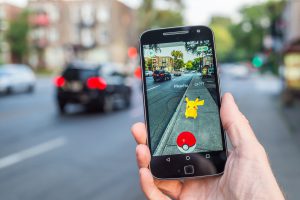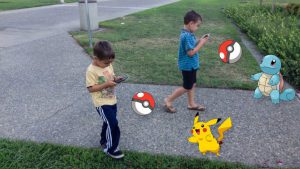From Katya: One of the weirdest gaming experiences I have ever had was the release of Pokemon GO in the summer of 2016. I downloaded the game like a good game studies human and messed around with it (until I caught a Jigglypuff, the best Pokemon and decided my career had peaked.) Much of the hype around the release was its use of AR (augmented reality) that put the Pokemon in actual space. (And now you can take selfies with them! Not going to lie, my inner child is pleased.)
It wasn’t the AR that was interesting– to be honest the game works better if you don’t use it– but rather the impact the game had on how players navigated everyday space. I have a habit of regularly walking across the University of North Carolina’s Chapel Hill campus and so I have a pretty good idea of where it’s busy and which spaces on campus are often empty. (Hint: in the summer, its most of them.) Like many campuses in the US it became dotted with digital Poke-Stops and Gyms, GPS locations where players can collect items and battle one another to play the game. Over the course of a few weeks the pull of these locations changed how the campus worked. A fountain in the middle of a parking lot became a gathering place because it was also a Gym. New paths were being worn through lawns and gardens so players could hit a Stop on their way to and from class. There were also younger kids and adults that would usually not be on campus wandering around on a mission to fill out their Pokedex. And it wasn’t just Chapel Hill: Niantic (and several players) were charged with trespassing as players were trekking across private property just to get that Bulbasaur. The game effectively changed how players moved through and experienced space.
Which was part of the point. Pokemon GO encourages players to explore their surroundings by placing Gyms and Stops at historic sites, public art displays, and other points of interest that players might not have noticed before. Of course, there’s nothing requiring that you actually look at that art or read that historic marker once you’re there, especially since your face is probably buried in your screen, but hey: you’re there and probably got a little exercise along the way.
Pokemon GO is approaching its third birthday and is far from new but it– and other games like it– have been on my mind. The premise of a lot of AR games is that they are supposed to change your experience of the actual world, usually to re-engage in it to combat the tired cliche that video games are totally escapist. (Which is both true and not. It’s Complicated, my friends, which is why we discuss!) And they certainly seem to but is the impact a meaningful one? From a gaming perspective, does AR have a better shot at changing how people engage in the world than VR?
From Hannah: Like Katya, I’m not a serious Pokemon GO player. My goals are basically to catch the cute Pokemon (like Clefairy) and entertain myself when I’m walking from my house to campus (who cares about exercise when you can hatch an egg?) or go on a trip. Katya’s right — when Pokemon GO first came out, it changed how people experienced everyday spaces that previously seemed boring.
I was in my hometown during its debut, and my sister and I joined hundreds of other players walking trails and the beach with renewed interest. But Pokemon GO has also distracted me from experiencing the “real world.” I’m not proud of this, but when I went to Italy after Pokemon GO was released, I spent some time hunting for Mr. Mime (there are some Pokemon that are only available in specific regions) and paid attention to little else.
My hunt for Mr. Mime does bring up a point about how Pokemon GO uses augmented reality: who can play this game? who is it built for? Not everyone can travel the world to collect all the Pokemon (although you don’t need to do this to play the bulk of the game). But there have been criticisms of the game for its lack of accessibility. Pokemon GO has always favored urban over rural players, although updated features in the game have made this better.
Some of these updates, like “Friends,” allow you to build virtual communities that augment playing with your friends in person or discussing the game in online forums. But do these games connect to other people as well as the world, or do they isolate us in our Clefairy-catching bubbles?
From Mav: Ooh! Ooh! A game discussion I can actually participate in! I also play Pokemon GO. In fact, I may play it the most of all of us. My reasoning is actually kind of silly. I have nieces and nephews aged 3 through 12 who are obsessed with it. But…. they’re children. They have limited time with their phones and limited mobility that they can travel to. Since, as Katya said, the game requires you to actually physically explore locations in order to collect Pokemon, that means that I… as an adult with unlimited phone access and a car and who sometimes travels to totally new locales by plane and stuff and who spends lots of time on busy college campuses… have WAY more Pokemon opportunities than they do.
Which makes me cooler…. and this is important… because I certainly can’t have children being cooler than me.

That said, I am also fascinated by the interactiveness of the game with the environment. The AR aspect of it forces you to engage with your physical space in a way that other games, in fact even other AR games, do not. There’s a question of what does it mean to have to go to the park in order to finally catch that elusive Girafarig or whatever. Your typical AR game focuses on the human’s interaction with the virtual (you as a player are attempting to manipulate objects in the virtual world). This seems to be more about placing the virtual in the physical (the creatures in the game attempt to exist in our reality).
I do wish it worked better. As Katya said, I actually mostly turn off the visual aspect of this, because honestly the game works better without it. But I do like that as a gameplay element there’s an aspect of the real and the virtual meshing in a way that is interesting and I think deserves some exploration. Sightseeing is not a new activity. People have always walked around to enjoy parks and gardens or statues and architecture. Interesting rock formations. Whatever. What is the effect of mixing that with the game? Are the same exploration? Do they enhance each other? It’s cool to find a Mr. Mime. It’s cool to climb Mt. Everest. Is it super cool to find a Mr. Mime at the top of Mt. Everest? Are both experiences enhanced? Is neither? Do they take away from each other?










I really wanted to enjoy Pokemon Go when it came out, but I eventually bounced off it after the initial month or so (even though I bought a top model cellphone specifically to play it.) I love how it changed the landscape of reality though (although the AR camera mode destroyed the battery so was only good for taking the occasional funny social media picture.)
I’m a big fan of these games that bleed in reality. They’re usually too much for me, but reading articles about how some Ingress players recruited someone who frequently traveled in order to help make some big chain of portals or whatever and then organized some clandestine meeting on some isolated island in the middle of fucking nowhere to do some big dumb thing in a game is… astounding. It’s just really cool.
Or similarly, any of that Eve Online stuff where people are doing like corporate espionage level stuff and stealing millions of real life dollars through virtual dollars that are funneled into these virtual spaces.
Anyways, speaking personally on augmented reality. I think it’s the way of the future. Snapchat filters are just one example of that. The genderswap filter thing everyone was fascinated by a month or so ago is another. Imagine a world where we can just change our perceived gender, clothes, hair, etc. through the augmented looking glass. It can’t get here soon enough, there’s so much potential (although with things like google glass not succeeding because of the privacy/camera issues it may take longer than originally thought.)
As for it impacting life, I will say I played a Shin Megami Tensei game for an entire year trying to “pull” a certain demon because the game allows you to summon anything you’ve caught in an augmented reality camera mode. The monster in question is basically an eldritch phallus/screaming penis in a chariot, and the ability to just summon that at will was too good to pass up (see attached photo.) I stopped playing the game shortly after because I just didn’t have the time/dedication for it, but it certainly consumed a year of my life for just a silly thing.
I’ve played a ton of these games (and even turned it into a career). Not many (or really none) have gotten the AR part beyond being a novelty meant for sharing funny pictures on social media. The closest I’d say is SILENT STREETS MOCKINGBIRD which opens these little interactive AR crime scenes when you’ve walked far enough. It’s a really cool idea but their implementation was frustrating to interact with most of the time. I’m sure someone will crack that nut soon.
I love Pokemon Go. I’ve met lots of great people raiding and attending events. I even got my boyfriend to start playing in his level is in the mid 30s already.
I’ve played a ton of location-based games with AR elements (and even turned it into a career). In that particular genre of game, so far, no one has really taken AR beyond a mechanism for sharing funny pictures on social media. Of the games I’ve played, SILENT STREETS MOCKINGBIRD has come the closest. After you walk certain distances, between other bits of the story, you unlock little interactive AR crime scenes. The rules for interactivity they set were frustrating and the AR scenes would show up at the most inopportune times, but it’s a great idea. Surely someone will take the idea and run with it.
(Sorry if you get two comments from me; browser crashed and it’s unclear if my first actually went.)
I still play Pokemon Go. I already love Pokemon games because I like compulsively collecting things, so there’s that. It also gives a socially anxious and awkward middle-aged geek like me a way to meet new people. It has also alerted me to places of interest in areas I regularly visit because I just never bothered to explore before.
I still play. It’s something to do with my kids and occasionally coworkers. Sometimes I’ll go out of my way to catch new Pokemon. It’s nice to see my distance walked. I don’t really think about it very much, but I like something to do while I’m walking around.